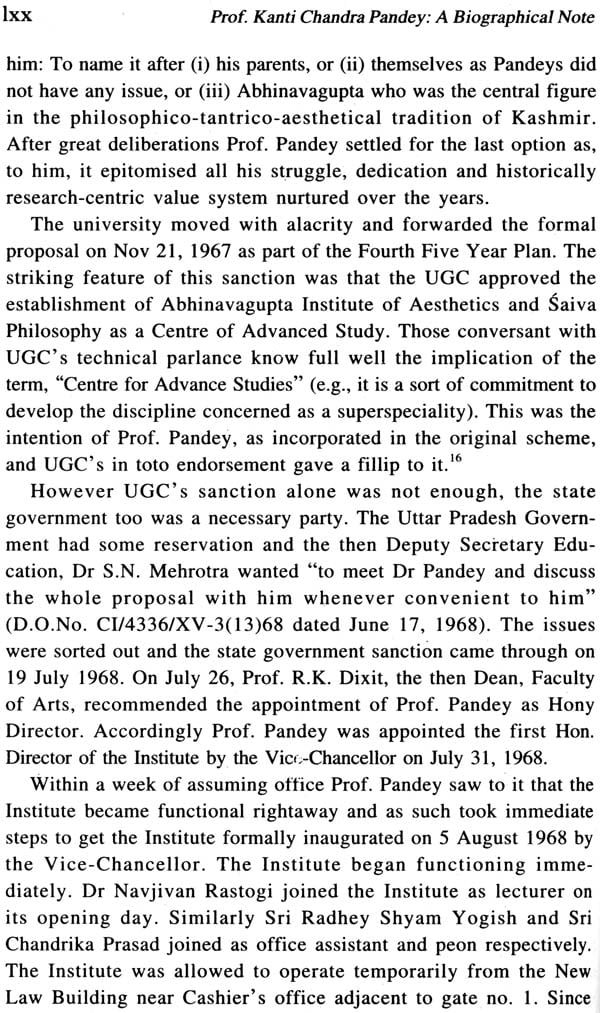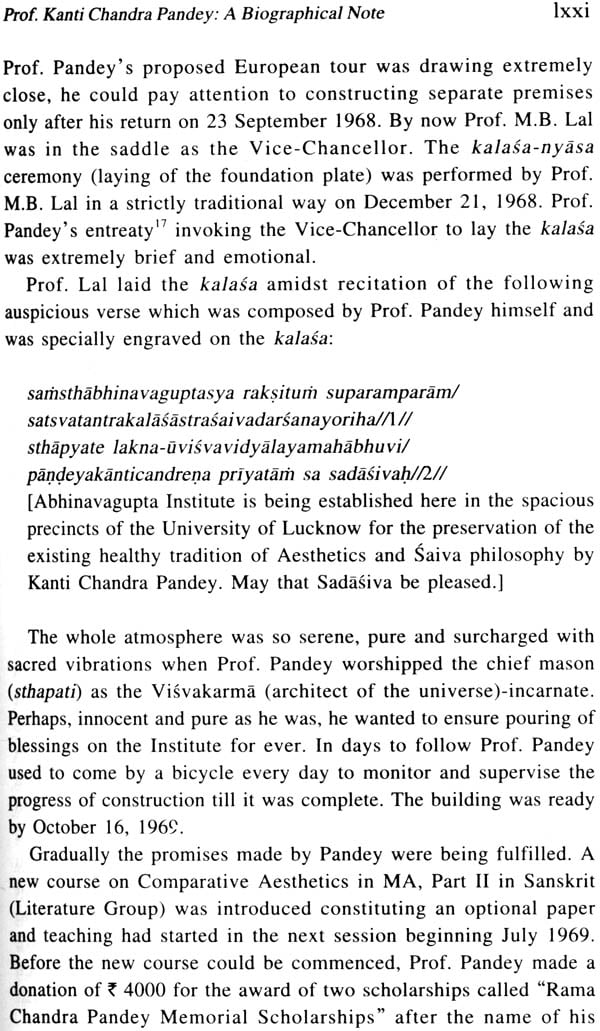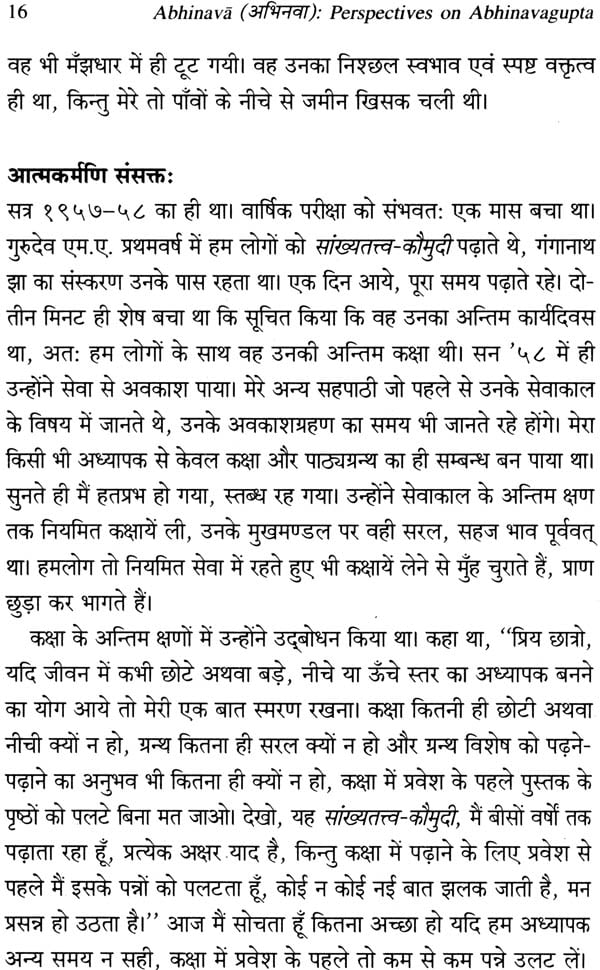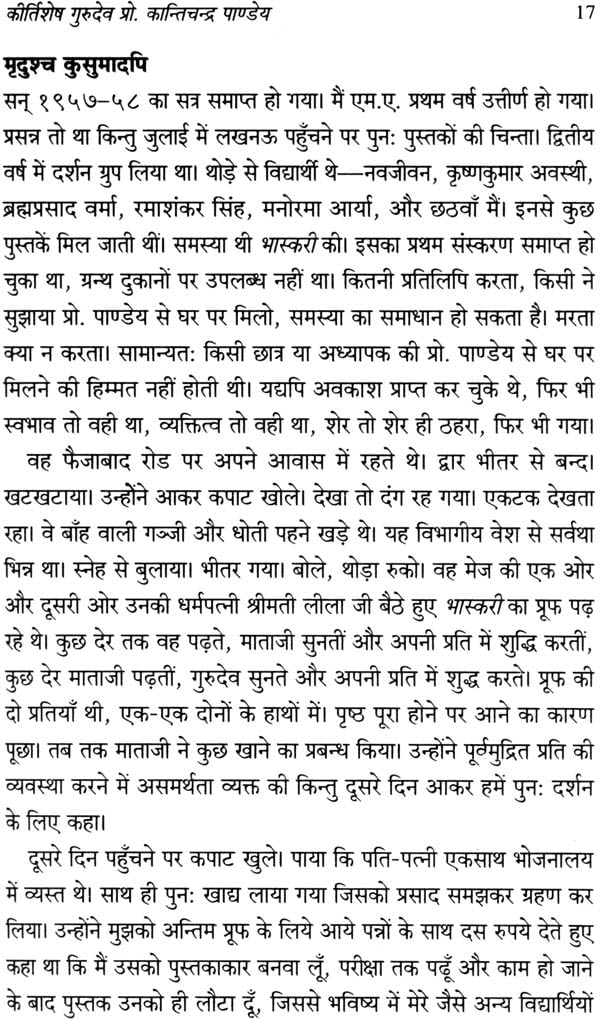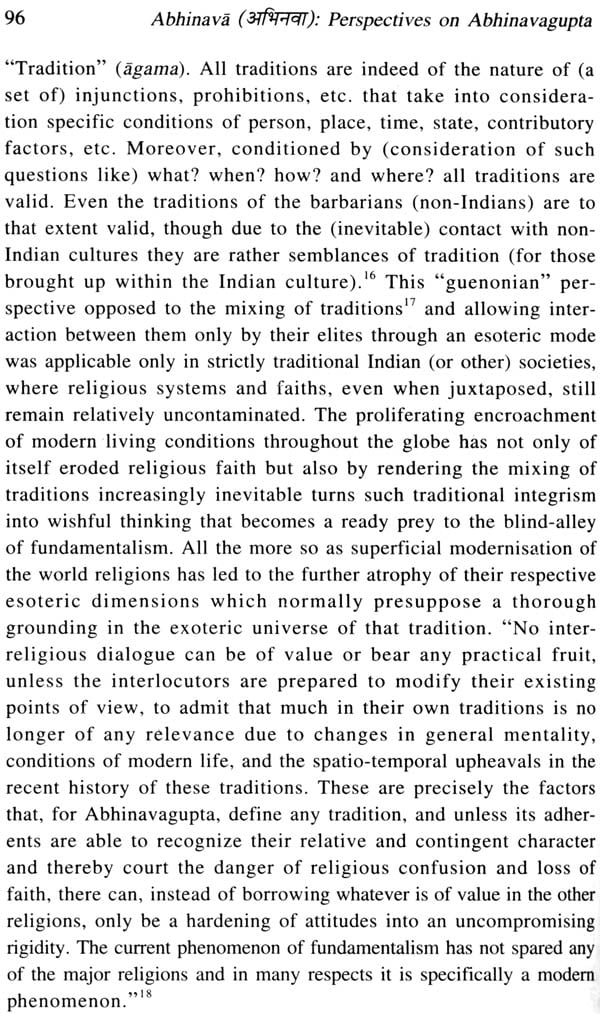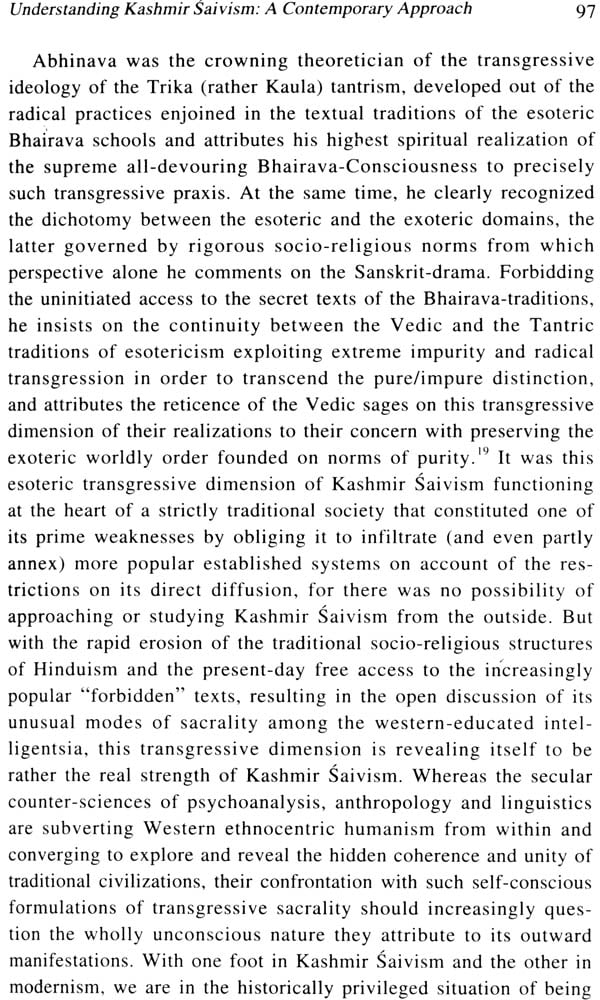
Abhinava "Perspectives on Abhinavagupta" (Studies in Memory of K.C. Pandey on His Centenary)
Book Specification
| Item Code: | NAK968 |
| Author: | Navjivan Rastogi |
| Publisher: | MUNSHIRAM MANOHARLAL PUBLISHERS PVT LTD |
| Language: | English and Hindi |
| Edition: | 2013 |
| ISBN: | 9788121512251 |
| Pages: | 658 |
| Cover: | Hardcover |
| Other Details | 8.5 inch x 5.5 inch |
| Weight | 900 gm |
Book Description
Till the advent of Prof. K. C. Pandey on the Indological Horizon, the Sanskrit academy was hardly aware that Abhinavagupta-the most towering creative genius of medieval India- was more a philosopher than a literary critic and that his foray into poetics, in fact art and aesthetics as such, was to complement and substantiate his metaphysical and soteriological vision and that his contribution has been phenomenal in both the realms along with their allied and applied ramifications. It was largely for Pandey to unearth Abhinavagupta from the historical and academic oblivion and highlight the unique poignancy of Abhinavan contribution as being nurtured by a unified dynamic integral world-view having perfection, that is, oneness of the being and the beautiful, experience and expression, beingness and bliss, foundationally enshrined in its epicentre. Thus, Pandey proved to be a "path discoverer," pathikrt and a "system-builder," tarkasya kartii. He consistently, and cogently, demonstrated through his numerous writings the intrinsically reciprocal congeniality that obtained between the Trika ietaphysics on the one hand and its aesthetics on the other, where the former constitutes the genesis (kiirwJa hetu) of the theory of art and the latter the psycho-epistemological synthesis to the proper understanding of the tantrico-philosophical stipulations.
The volume opens with a fairly long preface introducing the underlying theme and spirit of the whole venture followed by a biographical essay on Pandey's inspiring life plus a comprehensive bibliography of his writings. The opening segment is followed by the Part One comprising reminiscences from a cross-section of his students and admirers including quite a few surviving close associates and contemporaries. The next two parts constitute the substantive portion and are devoted to Kashmir Shaivism and Abhinavan aesthetics, respectively.
Navjivan Rastogi, besides being a pupil in the direct lineage of K'C, Pandey, is privileged to have been a colleague of his master and mentor for six years with whom he (jointly) edited an anonymous sub-commentary on Abhinavagupta's lsvara-pratyabhiji'iti-vimarsini (unpublished). Formerly Honorary Director of the Abhinavagupta Institute of Aesthetics and Saiva Philosophy, founded by his teacher K'C, Pandey, he retired from active service as the chairperson of the Department of Sanskrit, Pali, and Prakrta languages, University of Lucknow. Navjivan Rastogi came to prominence with the publication of his Krsme Tantricism of Kashmir, vol. I. His other major works for which he is known are: An Introduction to the Tantraloka: A Study in Structure and Kesmirs Siviidvayaviida ki Mala A vadhiiralJiiyeli "Key concepts of the Shaiva Monism of Kashmir"), in Hindi. He has also edited Tantriiloka with the Viveka of Jayaratha, in eight volumes jointly with RC, Dwivedi. His most recent publication is Abhinavagupta kii Tentrsgsmiye Dsrsens. At the moment, his two works are in press. Presently he is, inter alia, associated with Karl H. Potter in editing the EIP Encyclopaedia of Indian Philosophies), volume on Kashmir Shaivism.
Meera Rastogi, the joint editor, is a direct student of Navjivan Rastogi. She has recently published her doctoral dissertation "Tantrika Sivadvayavada men Iccha-svatantrya tathta (Encyamanavadia" ("Free will and Determinism in Tantric Sivadvayavada"), As a former General Fellowship awardee of the Indian Council of Philosophical Research, she wrote a Monograph entitled "Abhinavagupta's Theory of Speech" (unpublished), Presently, she is a lecturer in Sanskrit, University of Lucknow.
Close on the heels of the centenary year of Prof. K.A.S. Iyer (i.e., 1997-98), the year 1998-99 turned out to be the hundredth birth anniversary of Prof. K.c. Pandey-the next founding pivotal figure of the Sanskrit Department of the University of Lucknow. The Departmental Committee decided to celebrate Prof. Pandey's centenary year in an equally appropriate manner. As a substantive step lending depth to the content of celebration it was decided to bring out a commemoration volume focused exclusively on the areas namely Kashmir Saivism and aesthetics, to the nourishment of which Prof. Pandey dedicated his whole life.
Abhinavagupta, besides being the most towering creative genius of medieval India always appealed to Prof. Pandey's heart to the core as the ultimate authority and source of the Saiva thought of Kashmir and Indian aesthetics. In fact he became quintessential to the thought and very being of Prof. Pandey. This led us to christen the volume as Abbinsvs: Perspectives on Abhinavagupta, secure in the belief that this was the best and most befitting way of paying our homage to Prof. Pandey. The volume comprises three parts. The part One focuses on the persona of Prof. Pandey comprising a biographical essay and reminiscences on his life, works and rich legacy. The next two parts constitute the substantive portion and are devoted to Kashmir Saivism and Abhinavan aesthetics, respectively.
Pandey's advent on the Indological horizon was like a bout of fresh breeze. Till his time the Sanskrit academy knew of Abhinavagupta only as a literary critic, that too mostly through second hand referrals and valuations such as the SahityadarpaIJa and the Kavyaprakasa. The scholarship in general was hardly aware that Abhinavagupta was more a philosopher than a literary critic and that his foray into poetics, in fact art and aesthetics as such, was to complement and substantiate his metaphysical and sotereological vision and that his contribution has been phenomenal in both the realms along with their allied and applied ramifications. But for a miniscule pocket of scholars in Kashmir who could perhaps claim access to the residual trickle of the oral tradition, it must be considered to be practically dead, especially so far as the interpretation of his works was concerned. It was M.M. Shivakumar Shastri, at a synchronous point of time, who started reviving Kashmir Saivisrn in Varanasi. Though he wrote little, he was singularly responsible for inspiring Jai Shanker Prasad, the celebrated poet of the great Hindi epic Kemnyent embodying the imaginative transfiguration of the philosophical ethos of Kashmir Shaivism and his brief essays abounding in profound historical, philosophical and poetical insights and understanding of the same. However it was for Pandey to carve out a new diction groomed on his professed dedication to the textual authenticity with pieces of his foundational research and his translation of Abhinavagupta's lsvara-pratyabhijiia-vimarsini. He proved to be a "path-discoverer," pstbikit, and a "system-builder," tarkasya karta. Similarly in aesthetics, he tackled the Western sceptic's challenge head-on as to whether there was aesthetics in India and whether Indians had any sense of the beautiful thought. Pandey' s affirmative answer proved catalystic in demonstrating the existence of full-bodied aesthetics in India in almost all the major meaningful dimensions through his exposition of Abhinavagupta. In the context of post-modernism, which heralded an era of the end of all grand narratives, Pandey's venture assumes an added relevance, with the poser: could a grand all-encompassing theory of beauty be contemplated? One can look forward, in search of an answer, to either of the two fundamental convictions stemming from the interdependence of all arts or its absence proclaiming independence and self- centricity of each art. Abhinavan answer emerging from the ideational background of Indian thought, thoroughly processed under the shadow of the tantric metaphysics of Kashmir Shaivism, presents an ingenuous synthesis of the two: while retaining the intrinsic individuality of each art both technically and experientially, he develops a unified theory of beauty in whose terms all arts could be significantlv correlated.
In the history of Indian speculation on art three figures occupy centre space by virtue of their profound classical theorization, viz., Bharata, Anandavardbana, and Abhinavagupta. Viewing drama as central to the aesthetic activity Bharata's approach is characterized by pragmatic considerations of an overarching performing art. Ananda- vardhana, though primarily a literary critic, offers deeply original insights on communication of the poetic, and for the reason of that art-, meaning by exploiting relatively all-extensive canvas of dhvani, "suggestion;" Abhinavagupta's multidimensional approach exhibits three clear directions. In the first place, he acts as a founding exponent of the dramaturgical legacy of yore through classical exegesis of Bharata and dialectical synthesis and integrating contextualization of diverse dramatic traditions. In the second place, while retaining intact the unhindered flow of erstwhile classical poetic theory he imparts timeless profundity to Anandavardhana's historical effort pertaining to the articulation and conveyance of the poetic meaning. As an inner current of this very process he fully exploits dhveui principle for bringing out the core meaning of the drama by synthesizing the two aforesaid areas and unearthing the essential unity of the poetic and dramatic meanings. In the third place, he lays down a philosophical, spiritual and rational basis, which is also at once concrete, comprehensive and holistic, to his aesthetical formulations in the light of the Trika beliefs. In this effort Abhinavagupta' s role is truly monumental and no other Indian scholar, to our knowledge, can even aspire to stand up to him. The unique poignancy of his contribution gets further boosted by the fact that all the three directions emerge from a single dynamic integral world-view having perfection, that is, oneness of being and beautiful, experience and expression, beingness and bliss, foundationally enshrined in its epicentre.
Abhinavagupta nurtures this integral world-view, life-view in other words, and the logico - soteriological component of his aesthetic thinking (outlined as the third dimension above) in his several philosophical works such as the Isvsrepretysbbijiis-vimersint Isvarapratyabhijiiavivrtti-vimarsinI, Tentriiloks, Melinivijeyevtattike and Psrstrimsiknviverene. These works may be divided into two groups-one, the Pratyabhijfia literature of the Trika which includes the first two texts and two, the Tantric literature of the Trika that consists of the latter three texts. Really speaking these three constitute a sort of single whole. What is remarkable is to note that despite unity of the basic philosophical vision, these two groups deal with two divergent aspects of art speculation with shifting focuses. Broadly speaking, in the former we come across the rational treatment in the light of the Pratyabhijfia metaphysics and in the latter, praxis-oriented analysis in the wake of the Pratyabhijfia life-perspective. Note that the Abhinavabharatl and Locana completely lack philosophical element, but that becomes secondary, instead, they develop a primarily aesthetical architecture keeping philosophical considerations in the background.
In the Tantric stream of thought the discussion on art or beauty has taken place, if one may say so, under a pragmatic compulsion. The thought in India has been basically "realization" -centric. It simply means that the quest after truth has never been a barren intellectual exercise, but has always symbolized a phase of life capable of being actualized, realized. This is a distinctive bonding cord of all modes of Indian thinking. Thus, enabling even an ordinary man to discover the highest truth and imbibe the same within one's life-span becomes the immediate concern of the tantric spirituality. In this concern lies the 'seed of the rise of art-speculation.
In the Indian spirituo-metaphysical domain the philosophical process turns out to be essentially a perceptual process. Reality is Awareness, and Self-experiencing is the sole unhindered access to it. Despite its ready countenance in the world, this awareness is not worldly, rather it is trans-worldly, i.e., transcendental. The chief constraint of the philosophical speculation happens to be its dependence on reason. We notice that there are three elements to the key thesis- "Reality is perfect ideality" -of the Trika:
i. It belongs to life.
ii. It is experiential in character.
1Il. Despite its worldly connection, it lies beyond worldliness, i.e., its trans-worldly.
It, therefore, stands to reason why we chose to concentrate on Kashmir Shaivism in the part Two and on Abhinavan aesthetics in the part Three. It does not, however, mean that general and ancillary issues are skipped altogether, but what is -primarily intended is to allow Abhinavan metaphysics as well as theory of art in its extensive ramifications to occupy the central focus.
